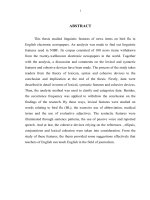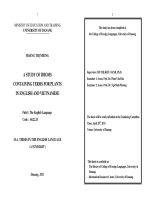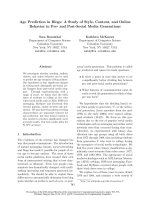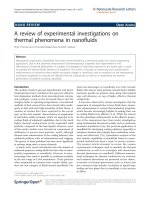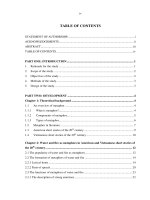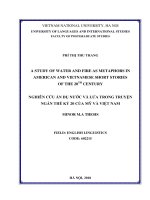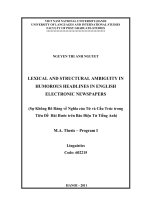A study of linguistic features of news items on bird flu in English electronic newspapers
Bạn đang xem bản rút gọn của tài liệu. Xem và tải ngay bản đầy đủ của tài liệu tại đây (335.17 KB, 26 trang )
MINISTRY OF EDUCATION AND TRAINING
THE UNIVERSITY OF DANANG
HỒ THỊ KIM HUỆ
A STUDY OF LINGUISTIC FEATURES
OF NEWS ITEMS ON BIRD FLU
IN ENGLISH ELECTRONIC NEWSPAPERS
Field
Code
: THE ENGLISH LANGUAGE
: 60.22.15
M.A. THESIS OF ARTS IN SOCIAL SCIENCES AND HUMANITIES
(SUMMARY)
DANANG, 2013
The thesis has been completed at the College of
Foreign Languages, Danang University
Supervisor: NGUYỄN THỊ QUỲNH HOA, Ph.D
Examiner 1: Nguyễn Văn Long, Ph.D
Examiner 2: Assoc. Prof. Dr. Trần Văn Phước
The thesis was defended at the Examining Board at the University
of Da Nang
Time : December 15th, 2013
Venue: Danang University
The original of the thesis is accessible for purpose of reference at:
- The College of Foreign Language Library, University of Danang
- The Information Resources Centre, University of Danang
1
CHAPTER 1
INTRODUCTION
1.1. RATIONALE
In our world today, the word “health” evokes a major
concern for people. Nowadays, people are more and more aware of
the impacts of having a healthy lifestyle by updating news on health
via different ways such as magazines, newspapers, television, radio,
etc, but newspapers which have the longest history are still the most
reliable source of information and popular means of communication
since the time it came into being. This is because people can read
newspapers to update information at anytime and anywhere.
For students, newspapers become a good source of
knowledge to help improve their English skills as well as update
social issues. However, together with the great development of
science and technology, the trend of getting news through electronic
newspapers is gaining ground.
The news on bird flu is one of the terrible occurrences that
have been attracting widespread public and global attention.
According to the The World Health Organisation (WHO), bird flu,
also known as avian influenza or avian flu or bird influenza, is an
infectious disease of birds caused by type A strains of the influenza
virus. It spreads between both wild and domestic birds, and also
passes from birds to humans who are in close contact with poultry or
other birds. In the report “H5N1 avian influenza: Timeline of major
events” updated on 25 January 2012 in The WHO, the Asian H5N1
virus was first detected in Guangdong Province, China, in 1996 and
its outbreak to many countries in the world has been reported on and
off in the media since then. Let’s consider the following sample of
2
English news items on bird flu at on 10 April 2013:
China H7N9 strain bird flu toll 'reaches nine'
Two more patients infected with the H7N9 strain of bird flu died on
Tuesday, bringing the total to nine, Chinese state media has
reported.
The two patients were from China's eastern Anhui and Jiangsu
provinces, state media said.
The World Health Organisation (WHO) has said that there is no
evidence that the H7N9 virus is being transmitted between people most cases come from poultry.
A total of 28 people in China have been infected by the new bird flu
virus. China has banned live poultry trading in Shanghai and
Nanjing.
On Monday, the WHO said it was in discussions with China about
sending a team of international experts to help investigate the new
bird flu strain.
The H7N9 bird flu virus is distinct from the H5N1 virus that has
caused more than 360 deaths worldwide since it was found in
humans in 2003.
Meanwhile, China's state-run news agency Xinhua said that 10
people from five different provinces had been detained over the
spread of false information about H7N9.
Some of them had written micro blog posts saying that the virus had
been discovered in their province, and some messages had been
reposted several times, Xinhua said.
3
Over the weekend, there were concerns about human-to-human
transmissions after the sons of an elderly man who died from bird flu
also contracted a respiratory illness. One of the sons died.
However, Chinese officials and the WHO confirmed on Monday that
the son's death was not caused by the bird flu virus.
"Although we do not know the source of infection, at this time there
is no evidence of sustained human-to-human transmission," Michael
O'Leary, the WHO's representative in China, told reporters on
Monday.
"We are very satisfied and pleased with the level of information
shared [by the Chinese authorities]," Mr O'Leary added.
In 2003, officials were accused of covering up the outbreak of Severe
Acute Respiratory Syndrome (Sars), a disease which infected 8,096
worldwide, and killed 744.
From the sample above, news is in a written text which has
systematically linked ideas within paragraph thanks to the use of
cohesive devices. Also the passive voice is employed by the writer to
denote the consequences of bird flu outbreak. As a teacher of
English, I realize the importance of helping students have a better
understanding of the features of linguistics in order to improve their
skills of English, especially in newspaper styles and broaden their
knowledge of social issues. Therefore, “A Study of Linguistic
Features of News Items on Bird Flu in English Electronic
Newspapers” is the title of the master thesis I do wish to carry out.
With an attempt to examine news structure, lexical choices, syntactic
features and cohesive devices in newspaper language, I do hope that
the results of the research will make some contribution to the process
4
of teaching and learning English. This is the reason that makes me
take a serious concern in doing this research.
1.2. AIMS AND OBJECTIVES
1.2.1. Aims
The aim of the research is to carry out a discourse analysis of
news items on bird flu (NIBF) in English electronic newspapers in
order to find out the features of news structure and tpical discourse
features. Besides, the findings of the study are expected to increase
the knowledge and effective use of these linguistic features in
teaching and learning English, especially for journalism.
1.2.2. Objectives
The objectives of the research are:
- To describe the discourse features of NIBF in English
electronic newspapers in terms of their news structure, lexical
choices, syntactic features and cohesive devices.
- To suggest some implications for teaching and learning
English as well as English for journalism.
1.3. SCOPE OF THE STUDY
This study concentrates on the investigation of some
linguistic features of news items on bird flu in English electronic
newspapers in terms of structure of news, lexical choices, syntactic
features and cohesive devices.
In spite of various means of publishing this kind of news
items, our scope of investigation is limited to news items in 8 wellknown English electronic newspapers in the USA and the UK such
as the BBC News, the Guardian, the Huffington Post, the Mirror, the
New York Times, the Telegraph, the US News and the Washington
Post.
5
1.4. RESEARCH QUESTIONS
In order to achieve the aims and objectives of the study
above, the research tries to answer the following questions:
1. What is the generic structure of a news item on bird flu in
English electronic newspapers?
2. What are lexical choices and syntactic features and
cohesive devices of NIBF in English electronic newspapers?
3. What are some possible suggestions for teaching and
learning English as well as using English for journalism?
1.5. ORGANIZATION OF THE STUDY
The
research
includes
five
chapters:
Chapter
1
(Introduction), Chapter 2 (Theoretical Background), Chapter 3
(Methods and Procedure), Chapter 4 (Discussion and Findings) and
Chapter 5 (Conclusions and Implications).
6
CHAPTER 2
THEORETICAL BACKGROUND
2.1. LITERATURE REVIEW
In attempting to understand language, many well-known
scholars such as Halliday and Hasan (1976), Quirk (1985), Allan
Bell (1991), Biber et al (1999), Beaugrand, R. And Dresler, W.
(1981),etc have made a significant investigation into the linguistic
features of language.
In Viet Nam, many liguistists have made considerable
contribution to this field:
Diep Quang Ban (2003), Tran Ngoc Them (2006), Cao Xuan
Hao (1991), Nguyen Minh Thuyet and Nguyen Van Hiep (1998)
Additionally, doctoral dissertations and master thesises
raised some issues related to this field: Phan Van Hoa (1998)’s,
Pham Thi Thu Huong (2011), Phan Thi Hoai Thanh (2012).
With respect to newspapers, Pham Do Quyen (2001), Le Thi
Phuong (2011), Le Thi Hoai Tam (2011), Tran Cao Thao Nguyen
(2011) and Le Thi Thao Anh (2012 ) gave complete look at linguistic
features of different discourse.
From the studies presented above, the authors studied the
lexical features, syntactical features and cohesive devices in many
kinds of discourse but there is no evidence that any research on NIBF
has been taken into consideration. Therefore, “A Study of Linguistic
Features of News Items on Bird Flu in English Electronic
Newspapers” will be conducted with the aim of contributing a minor
part to this field.
7
2.2. THEORETICAL BACKGROUND
2.2.1. Text
a. Concepts of Text
Text in this thesis is viewed as 1) a language in use for
communicaton, (2) a language unit which has meaning, unity and
purpose, (3) a semantic unit which is written of words, pharses,
sentences, so its linguistic feature analysis should be approached
from the semantic perspective expressed and coded in words, phrases
and structures.
b. Features of Texts
According to Beaugrande & Dressler [3, p3], text is
established as a communicative occurrence, which has to meet seven
standards
of
textuality:
cohesion,
coherence,
intentionality,
acceptability, informativity, situationality and intertextuality. If any
of these standards are not satisfied, the text is considered not to have
fulfilled its function and not to be communicative”.
2.2.2. Cohesion and Coherence
Coherence has been applied to the concepts and relations
underlying its meaning and to some general overall, interrelatedness
in the text. In other words, coherence has been defined as continuity
in meaning and context in a discourse.
2.2.3. Newspapers and Electronic Newspapers
2.2.4. News in Electronic Newspapers
a. What is news
The general notion of news, meaning new information about
events, things or persons
b. Structure of news
There are 3 main parts in a news item:
8
Headline, Lead and Body which is clarified by Van Dijk
[41]. It has been traditionally compared to an inverted pyramid.
2.2.5. Defintions of News Item on Bird Flu
2.2.6. Bird Flu Overview
9
CHAPTER 3
RESEARCH DESIGN AND METHODOLOGY
3.1. RESEARCH DESIGN
The research design is a combination of qualitative and
quantitative methods.
3.2. RESEARCH METHODS
With the aim of achieving the set goal, several methods are
simultaneously employed such the descriptive method, the analytic
method, the inductive method.
3.3. DESCRIPTION OF SAMPLES
100 samples of NIBF collected from 8 English electronic
newspapers in the USA and the UK such as the BBC, the Guardian,
the New York Times, the Mirror, the Huffington Post, the Telegraph,
the US News, and the Washington Post (from 2006 to 2013) must
have 4 parts: Headline, Lead and Body, in which the average length
of the Body ranging from 200 to 400 words.
3.4. DATA COLLECTION
The data collected for this study was from 8 English
electronic newspapers (from 2006 to 2013) in the USA and the UK
such as the BBC, the Guardian, the New York Times, the Mirror, the
Huffington Post, the Telegraph, the US News, and the Washington
Post. The choice for these newspaper publications is hinged on
recency as well as the quality of the news delivery by the reporters.
3.5. DATA ANALYSIS
The analysis of the research was done in tandem with the
research questions. The news items on bird flu selected for the
analysis are in the form of written texts in English electronic
newspapers. After collecting and clarifying the data, I examined the
structure of news, lexical choices in NIBF. In analyzing the syntactic
10
features, I took into consideration the sentence patterns, passive
voice and reported speech. Aslo, I looked through the selected
sample to find out the use of cohesive devices in NIBF. The
frequency occurrence of each part was displayed in tables with
percentage terms. The results were discussed and evaluated from the
frequency of each category.
3.6. RELIABILITY AND VALIDITY
CHAPTER 4
FINDINGS AND DISCUSSION
4.1. STRUCTURE OF A NEWS ITEM ON BIRD FLU
Figure 4.1. Structure of a news item on BF
Here is an example of a news structure by Van Dijk:
11
12
13
4.2. LEXICAL CHOICES IN NIBF
4.2.1. Lexical Items Relating to Bird Flu
4.2.2. Compounding
4.2.3. Acronyms
4.3. SYNTACTIC FEATURES IN NIBF
4.3.1. Sentence Patterns in NIBF
a. Sentence Patterns in the Headline
Table 4.3. Sentence Patterns in the Headlines of NIBF
Types
Statement
Complex
Sentence
Elliptical
Sentence
Sentence
Headlines
Question
Compound
Sentence
Phrase Headlines
Total
Occurrence
47
Accroding to Quirk [35, p.53],
Rate
47
28
28
8
8
3
3
1
1
13
100
13
100%
the common declarative
structures of statements were analyzed in such patterns as SVO,
SVA, SVC, SVOC and SVOA.
Table 4.5. Patterns of Statement Headlines in NIBF
Patterns
Occurrence
Rate
SVO
12
25
SVC
2
4,5
SVA
5
11
SVOA
27
59,7
SVOO
1
2,3
Total
47
100%
14
As for phrase types, Quirk [35, p.1238] also distinguishes
two constituents: the head and the modification. The modification
can precede or follow the head, correspondingly named premodification and post-modification.
HEAD NOUN
Obligatory
Pre-modification
(Optional)
Post-modification
(Optional)
Pre-modification + Head noun
(1)
(2)
(4.44) Bird Flu Concerns
(1)
[144]
(2)
(4.45) H7N9 Bird Flu
[35]
(1)
(2)
Pre-modification + Head noun + Post modification
(1)
(2)
(3)
(4.48) Better Flu Vaccine On The Horizon
(1)
(2)
(3)
(4.49) The Horizon Guide to Pandemic
(1)
(2)
(3)
The Lead
b. Sentence Patterns in the Lead
Table 4.6. Sentence Patterns in the Leads of NIBF
Types
Occurrence
Rate
Simple Sentence
3
3
Compound Sentence
2
2
Complex Sentence
95
95
100
100%
Total
c. Sentence Patterns in the Body
[139]
[141]
15
Table 4.7. Sentence Patterns in the Body of NIBF
Types
Occurrence
Rate
1765
98,7
Compound Sentence
22
1,3
Total
1787
100%
Complex Sentence
4.3.2 Passive Voice
The passive voice is formed by the following structure by
Quirk [35]:
Subject passive + Verb passive (be/get + p.p) + optional Agent
(by-Phrase)
Cited below are some examples from the data set that
contained passive voice:
(4.63) Two cases were reported in the central Henan province,
while the others were seen in and around Shanghai, where the virus
first appeared in February.
[73]
Apart from the popular construction above, the passives in NIBF
sometimes go with modal verbs should, must following
the
construction below:
Subject passive + Modal Verbs (should/must) + Verb passive
(be + PP)
For instance:
(4.68) "Aggressive intervention to block further animal-to-person
transmission in live poultry markets, as has previously been done in
Hong Kong, should be considered," Kwok-Yung Yuen of the
University of Hong Kong, who led the study, told The Lancet.
[69]
16
The use of passive voice in NIBF can be summarized in the
table below:
Table 4.9. Passive Voice in NIBF
Passive
Occurrence
With agent
37
Without agent
472
Total
509
Rate
7,3
92,7
100 %
4.3.3. Direct Speech and Indirect Speech
The distribution of direct and in direct speech can be
summarized:
Table 4.10. Direct and Indirect Speech in NIBF
Types
Occurrence
Rate
Direct speech
345
72,3
Indirect speech
132
27,7
Total
477
100 %
As for the positions of the reporting clauses in NIBF, they
can occur in three positions: initial position which shows the
reporting clause preceding the reported clause as in (4.70); medial
position as in (4.71) and final position in which the reporting clause
is put after the reported clause as in (4.72). This can summarized in
the table below:
Table 4.11. Positions of Reporting Clauses in NIBF
Positions of
Occurrence
Rate
Reporting Clause
Initial
141
40,8
Medial
185
53,6
Final
19
5,6
Total
345
100 %
Here are some examples:
(4.70) The Government's acting chief veterinary officer, Fred
Landeg, said yesterday: "Data suggests that it's closely related to
17
outbreaks in the Czech Republic and Germany, which does suggest a
possible wild bird source.
[127]
(4.71) "In 2004, when H5N1 hit the market, it needed months to
recover," said Feng Zijian, vice director of the Chinese Centre for
Disease Control and Prevention. "The impact of H7N9 will continue
to be felt in the upcoming period. We just don't know how long this
bird flu will last."
[97]
(4.72) "We thought that people would try to avoid domestic
chicken, and have more preference for imported chicken, but this is
not the case. Across the board, people are being more cautious,"
said Sarah Li, director of the USA Poultry & Egg Export Council's
Hong Kong office.
[156]
The syntactic Features in NIBF can be summarized as
follows:
Table 4.12. Syntactic Features in NIBF
Types of Sentences
Occurrence
Rate
57
2
1892
67
Compound Sentence
28
1
Noun phrase
8
0,2
Passive Sentence
516
17,8
Direct & Indirect Speech
477
12
2975
100 %
Simple Sentence
Complex Sentence
Total
18
4.4. COHESIVE DEVICES IN NIBF
4.4.1. References
a. Personal Reference
The analysis of personal pronouns and possessive adjectives
b. Demonstrative Reference in NIBF
The analysis of the determiners, the definite article and the adverbs
c. Comparative References in NIBF
The analysis of particular comparison which compares
things in terms of quantity and quality.
The Summary of References in NIBF
Table 4.13. Summary of References in NIBF
F
E
R
E
Personal
References
E
TYPES
Demonstrative
References
R
C
E
Comparative
References
N
Personal Pronouns
Possessive Adjectives
Total use of Personal References
Determiners
Adverbs
Neutral determiners
Total of Demonstrative References
Occurrence
502
43
545
236
30
46
Rate
52,9
4,5
57,4
24,8
3,3
4,8
312
32,9
General Comparisons
0
0
Particular Comparisons
91
9,7
Total of Comparative References
91
9,7
948
100%
S
Total
4.4.2. Ellipsis
There are not many cases of ellipsis as these phenomena
tend to be more common in spontaneous speech, Quirk [35, p.855]
4.4.3. Conjunctions
a. Additive Conjunctions
The analysis the use of “and” and “or” in adding information
19
b. Adversative Conjunction
The analysis of “but” and “however” in expressing the
contrast.
c. Causal Conjunction
The analysis of “so” and “therefore” in expressing the cause/
reason
d. Temporal Conjunction
The analysis of the conjunction “before” and “since” in
knitting the preceding and the following information in terms of
time.
4.4.4. Lexical Cohesion in NIBF
The analysis of reiteration which involves the repetition of a
lexical item in terms of three sub-classes: repetition, synonyms.
The Summary of Cohesive Devices in NIBF
Table 4.16. Summary of Cohesive Devices in NIBF
Types of Cohesion
Occurrence
Rate
Reference
948
50,1
Ellipsis
23
1,3
Conjunction
288
15,2
Lexical cohesion
632
33,4
1891
100%
Total
20
CHAPTER 5
CONCLUSIONS AND IMPLICATIONS
5.1. CONCLUSIONS
This study set out to outline a theoretical tool kit for the
linguistic analysis of news discourse and then used it in the field by
analyzing news items based on a theoretical framework. The study
was carried out to get a full understanding of the typical features of
this kind of news. With this aim, I have set up major goals for the
thesis; i.e. to investigate and find out the linguistic features of NIBF
in terms of the news structure and their typical discourse features.
The findings below are presented in each category.
As for the structure of news in NIBF, the result of the
findings shows that the common structure in NIBF is as follows:
Headline, Lead and Body are the three main parts of the news
besides the supplementary of optional factors such as the time, the
name of reporter, hyperlinks, etc. The Summary consists of Headline
and Lead which summarize the news item. The Body deals with
main events, background information, consequences and comments
of people involved or of the reporter himself.
At the lexical choices, one important finding is that the news
is engaged on the extensive use of lexical items relating to bird flu as
well as abbreviations in terms of compounding and acronyms. It is
worth stressing that these features contributes to the success of the
news since they make the news concise, more informative and
impressed.
The peculiarities of these news items also lie in their
syntactic features. As the reporter is obliged to be brief but concise,
21
he naturally tries to cramp all his facts into the space alotted. This
resides in using the simple sentences taking up 53% in the headlines
to grap the readers’ attention. However, in order to convey more
detailed information of the deadly bird flu to the readers in a concise
way, the complex sentences are more significantly used in the body
of NIBF with 1765 occurences accounting for 98,7%, Besides,
passive voice with 17,8%, although, is not in a prominent position in
the findings, its utilisation in emphasizing the impact of bird flu has
as strong an effect as the use of some other features. Reported speech
is also an indispensable tool in the “source” stage which contains
original comments from the official authorities or experts involved.
Taking up 12%, direct and indirect speech are used to express the
objectivity and reliability of the news.
As regards cohesive devices, the study focused on four kinds
of cohesive devices that are reference, ellipsis, conjunction and
lexical cohesion, but reporters have a strong tendency to use
references and conjunctions. The reference is dominant. Among
three sub-categories of reference devices, personal reference is used
with the highest percentage of 52,9 %. The use of possessive
adjectives takes up 4,5 % whereas no cases of possessive pronouns
are found in the collected data. In the line of lexical cohesion in
NIBF, repetition is very commonly employed with 67,8% and
followed by synonyms with 32,2 %, but there is no case of superordinates in the data set.
In brief, the aforementioned observations are about the linguistic
features of news items on bird flu in English electronic newspapers
in term of lexical choices, syntactic features and cohesive devices.
22
Hopefully, this study contributes a minor part to the linguistic
analysis of news discourse.
5.2. IMPLICATIONS
Any research on linguistics is for two main purposes. First,
the research supplies readers with overall view of the problem.
Secondly, it orients readers
towards language teaching, learning and using, especially for
journalism.
For language teaching
The findings of this study can be a useful source for teachers
in teaching English. For example, with reference to teaching how to
write a piece of news
a framework of news, vocabulary relating to the topic as well as
appropriate syntactic structures must be considered carefully. As for
enriching students’ vocabulary on specific topics as well as
knowledge of social issues, this study might be useful.
For language learning
For learners of English, they are enriched with the bulk of
vocabulary as well as the linguistic features which support their
study, research, or knowledge of social issues. Additonally, through
the findings, learners can master how to use language in specific
field to obtain the best effectiveness in their study.
For language use for journalism
For journalism students, especially Vietnamese ones, who
are trained to write news in English should be provided with a
theoretical framework at discourse level in order to write good news
items on social issues in general and on bird flu in particular. Using
correct language, especially lexical choices in news writing is also
23
very important because it is one of the decisive factors which directly
influence the effectiveness of the news. Moreover, electronic
newspapers have gained ground in recent years. Once a piece of
news is uploaded, it is available not only for Vietnamese readers but
readers in the world. Therefore, the study hopes to bring about one
more reference to Vietnamese reporters to have a deep understanding
of linguistic features of news discourses to write well-captioned
news items of international stature. In other words, the acquisition of
knowledge on the choice of linguistic variables such as lexical
choices, syntactic features, and cohesive devices in NIBF will serve
as a means of educating both novice and expert writers of news items
on the acceptable rhetorical practices in their disciplines. In brief, it
is worth pointing out that the study’s outstanding contribution is
realized most especially for journalism .
5.3. LIMITATIONS OF THE STUDY
In spite of the fact that a lot of efforts have been made to
complete the study, it cannot help having certain limitations due to
the lack of time, reference materials as well as my limited linguistic
knowledge.
Firstly, the number of selected articles for analyzing is not
numerous, 100 samples are taken from 8 English electronic
newspapers in the USA and the UK. Secondly, I focused on the
linguistic features in terms of the structure of news, lexical choices,
syntactic features and cohesive devices. Therefore, there might be
other linguistic features which I have not examined.
5.4. SUGGESTIONS FOR FURTHER RESEARCH
